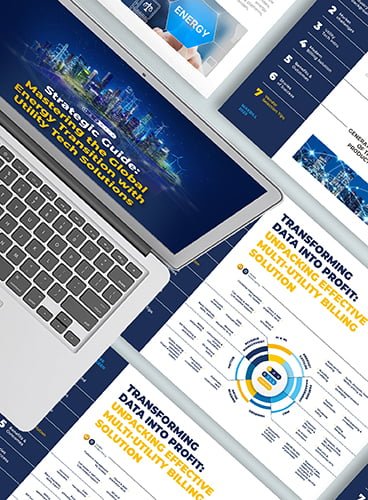Updated: May 7, 2025
You’re staring at fragmented billing data for each service in your Excel files. Another email just came in — a request to quote a new bundle that includes solar, broadband, EV charging, and tenant billing. You’re struggling because your current systems aren’t built for this level of complexity, where a single bill rules them all.
You know the game of multi-utility services has changed. Customers don’t just want energy anymore — they want everything. Clean power, seamless connectivity, smart home controls in one single bill.
The pressure is on — not just to deliver, but to do it efficiently, scalably, and ahead of the competition. You’ve got the ambition and the market signals.
But are your tools keeping up?
This article isn’t just about multi-utility services. It’s about why this model is reshaping the future of the energy and utility sector — and what decision-makers need to know to grow smart, not just fast.
Key Takeaways
- Today, modern multi-utility service providers deliver comprehensive bundles that include combined energy supply, EV charging, heating and cooling systems, landlord cover plans, smart home integration, communal solutions for tenants — charging into one, convenient bill.
- At MaxBill, we can name the top 5 challenges multi utility faces today: limitation in scaling a business, the complexity of managing diverse services and tariff plans, difficulties in operating new business models, accounting and billing errors, incompatibility of systems and data integration challenges.
- Tech solutions for multi utility should come with robust CRM and billing capacities as they are pivotal for adding new services and integrating with new partners, managing growing data bases, service specifics, bundling options, tariffs, etc.
- AI billing and product catalog are the just fit-for-purpose solution for the multi utility sector with complex service and product offers, intricate charging and calculations. etc.
- Water networks leveraging multi-utility tech solutions make their digital transformation even smoother since such technology streamlines multi-rate consumption tracking, multi-entity billing, regulatory compliance, and partner revenue sharing.
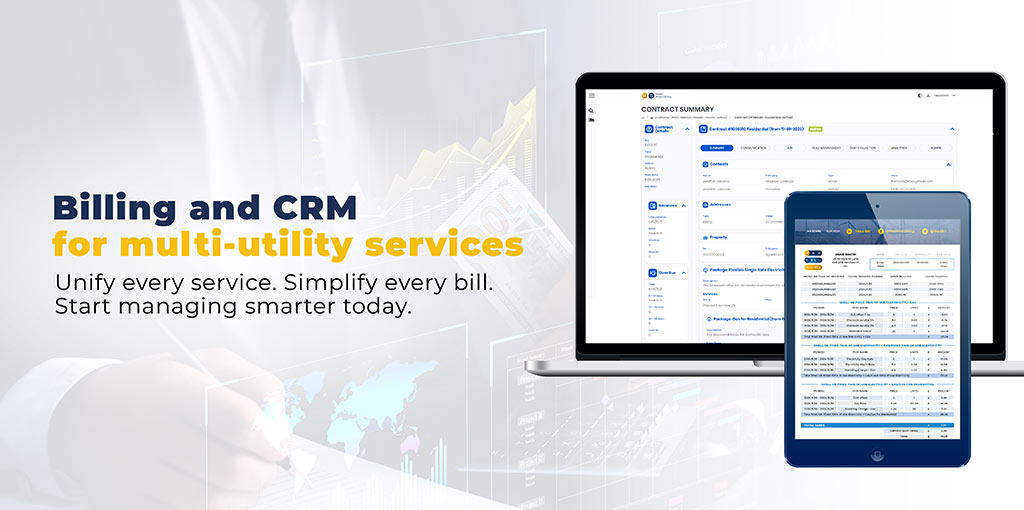
What are multi utility companies today?
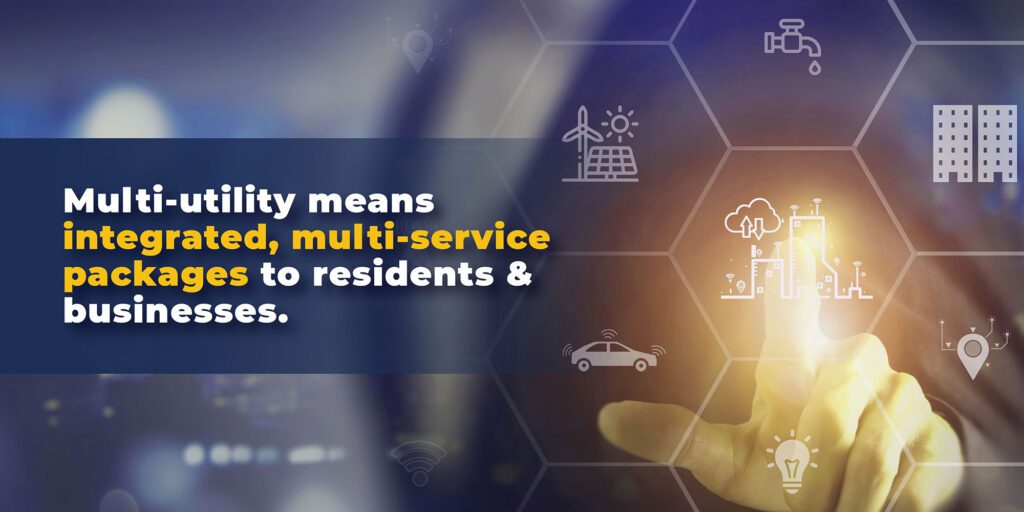
The energy transition, industry-wide transformations, and shifts in customer expectations are the driving forces for modern Energy & Utility companies to position themselves as multi-utility service providers, increasingly diversifying their offerings.
They are now presenting integrated, multi-service packages to both residential and commercial clientele. These comprehensive bundles typically encompass a wide array of solutions and services, including:
- Combined Energy Supply: This includes both electricity and gas, with an emphasis on renewable energy sources for multi-energy providers.
- Electric Vehicle (EV) Support Services: These services offer EV charging solutions, including the installation of sophisticated home smart chargers, along with attractive EV leasing options.
- Advanced Heating and Cooling Systems: Installation of air source heat pumps, providing efficient temperature control.
- Landlord Cover Plans: Comprehensive coverage for critical property components like boilers, central heating systems, plumbing, drainage, and electrical wiring.
- Smart Home Integration: A package that incorporates the installation of smart meters thermostatic controls, heat pumps, and solar panels complete with energy-storing solar batteries.
- Unified Utility and Communication Billing: A unique bundling of energy, broadband, mobile services, and insurance into a single, convenient bill.
- Communal Solutions for Tenants: Tailored tenant billing services facilitate streamlined management for communal living spaces.
These multi-utility offers represent a shift towards a more integrated, customer-centric approach in the E&U sector, reflecting the dynamic nature of current consumer needs and environmental considerations.
“Utilities aren’t selling energy anymore, they’re in customer service…”
[Enlit Quote]
We have now comprehensively understood the current landscape of multi-utility offerings. It is imperative to pivot our focus towards the pressing challenges faced by multi-utility service providers and explore strategic approaches for effective resolution.
Top 5 challenges multi-utility service providers face
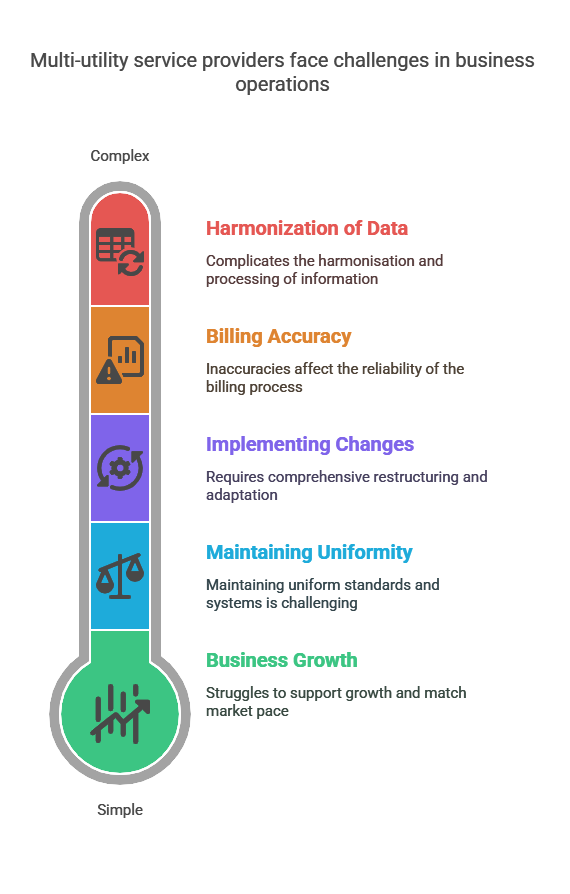
Having worked extensively with multi-utility service providers, we have gleaned significant insights into the complexities and challenges of this sector. Based on this experience, we have outlined the top challenges such companies face nowadays.
Limitations in Scaling a Business: As the company expands and the market grows more complex and competitive, the existing billing systems often need help to support and match the pace of the company’s growth. This limitation hampers the ability to scale effectively and efficiently.
The complexity of Managing Diverse Services and Tariff Plans: Each service in a multi-offer utility portfolio comes with unique billing and accounting requirements. This diversity creates challenges in maintaining uniform standards and systems for accurate accounting and billing. For instance, hydro billing demands a specific bill format, adding to the complexity.
Difficulties in Operating New Business Models: Implementing new business models, like tenant billing, necessitates changes in the existing billing system. This transition can be challenging as it often requires comprehensive restructuring and adaptation.
Accounting and Billing Errors: The diverse range of services, tariffs, and customer types, along with their interrelationships, can lead to errors in billing. These inaccuracies affect the correctness and reliability of the billing process.
Incompatibility of Systems and Data Integration Challenges: Integrating data from various sources, such as solar panels, charging stations, and cooling systems, presents difficulties due to inconsistencies in data structures and formats. This issue complicates the harmonisation and processing of information. Additionally, technology upgrades are costly and labour-intensive, requiring updates across different systems.
Multi utility solutions: addressing challenges of utility services

Primarily, multi-utility companies need to identify utility tech solutions with powerful CRM and billing capacities. They should adhere to key criteria, reflecting the ‘multi-play’ nature intrinsic to multi utility service providers. The following outlines the critical components that such a solution must encompass:
Facilitation of New Services and Integration with Partners
Multi utility solutions must be versatile enough to handle multiple types of services such as electricity, hydrogen, cooling, electric vehicle charging, and renewable generation. It should support the introduction of new business models, including tenant billing, through configurable business processes and partnerships for revenue sharing.
Comprehensive CRM and Reporting Functions
A robust Customer Relationship Management (CRM) system is essential, along with detailed commission reports and calculations with partners. The solution should also provide analytics capabilities, like tracking churn rates and managing debts.
Multi-Play and Cross-Product Functionality
The solution must offer multi-play capabilities, allowing for the simultaneous provision of services across different domains. This includes multi-rate consumption, multiple configurations, and the management of various business processes. It should cater to multi-company, multi-country requirements with multi-language, multi-currency, multi-tax, and multi-address functionalities.
Service Specifics and Bundling Options
The platform should support a range of services, including electricity and hydrogen supply, heating and cooling services, EV charging, and renewable generations. It must facilitate bundling these services with pricing and discount options, enhancing a utility customer experience.
Management of Diverse Services and Tariffs
The ability to manage various services and tariffs is crucial. This includes handling complex invoices that showcase multiple offerings and ensuring accurate billing for each service type.
To successfully expand their product and service offerings, multi-utilities should consider applying the most common range of tariff structures and contractual agreements.

Understanding Tariff Structures in Multi-Utilities Industry

Dual-Fuel Tariff: This service combines electricity and gas supply, offering customers a singular quote for both utilities. It simplifies management and billing by integrating these two essential services.
Fixed Tariffs: These tariffs lock in the prices for electricity and gas for a certain period, often including 100% renewable electricity. Typically cheaper for those paying by Direct Debit, they are ideal for budgeting. Home solutions discounts may be available under this tariff, offering additional savings.
Variable Tariffs: Unlike fixed tariffs, variable tariffs have fluctuating prices, which can change every three months in alignment with Ofgem‘s price cap updates. Under this tariff, the price of gas and electricity cannot go above the Ofgem-set energy price cap.
Single-Rate and Off-Peak Tariffs: Both variable and fixed-rate tariffs can be single-rate or offer off-peak prices. To access off-peak tariffs, customers typically need a specific meter, like Economy 7, which provides lower rates during certain hours.
Tariffs related to Government Initiatives: for example, Smart Export Guarantee (SEG) Tariffs. In the UK, this tariff is part of a government-backed initiative where small-scale generators are compensated for low-carbon electricity exported back to the National Grid. SEG Licensees determine the rate, contract length, and other terms for these generators.
EV Charging Tariffs: Tailored for residents with electric vehicles, these tariffs require a smart meter that provides half-hourly updates on energy use. They support efficient EV charging, catering specifically to the needs of EV owners.
Business-Specific Tariffs: Designed for SMEs and large businesses, these tariffs offer multi-site billing, flexible tariff structures, and half-hourly metering options. They are especially beneficial for large businesses with specific needs such as Out of Contract Rates, Deemed Contracts, or Fixed Term Contracts.
Additional Discounts and Support Schemes
Discounts are an integral part of many tariffs, providing additional incentives and savings for consumers. For example, the Energy Bill Relief Scheme (EBRS) in the UK offers discounts for non-domestic energy customers, including businesses, which helps in managing their energy costs more effectively. Therefore, a modern utility billing platform and CRM platform for multi-utilities should factor in this aspect of the industry offering and be configurable enough to integrate emerging governmental initiatives.
Service alterations with AI billing and AI product catalog
Recently, MaxBill has launched AI-driven billing and product catalog modules, available immediately without prior implementation project. It’s a perfect solution for B2B energy and multi-utility companies with complex commercial offers, intricate contract, calculations and financial settlements.
Besides creating offers and portfolios in a matter of clicks, it do service alterations quickly and with zero errors thanks to hyperautomation. Thus, if utilities need to modify the way the service is delivered, either in its structure, scope, terms, or availability, – it’s done in a matter of clicks, once prompted properly.
This kind of modifications includes:
- Switching from one tariff or plan to another
- Adding or removing services from a bundled package
- Upgrading or downgrading service levels (e.g., increasing broadband speed or changing heating system support)
- Changing contractual conditions, such as billing frequency or payment method
- Modifying technical configurations like meter types or charging hardware.
Multi-utility solution for billing and CRM within water networks
The multi utility solution with robust billing and CRM capabilities includes multi-rate consumption tracking, multi-entity billing, regulatory compliance, and partner revenue sharing. It aligns well with how modern water utilities operate — especially those seeking digital transformation.
It supports:
- Multi-service billing (electricity, gas, EVs, etc.), incl., water as an additional utilit
- Complex tariff structures, e.g., variable tariffs, usage tiers, and seasonal pricing
- Tenant billing and communal metering — very common in water networks for multi-dwelling units
- Data integration — including from smart water meters and flow sensors
- Service-specific bundling — e.g., water + drainage + heating in landlord cover.
Conclusion for utility leaders
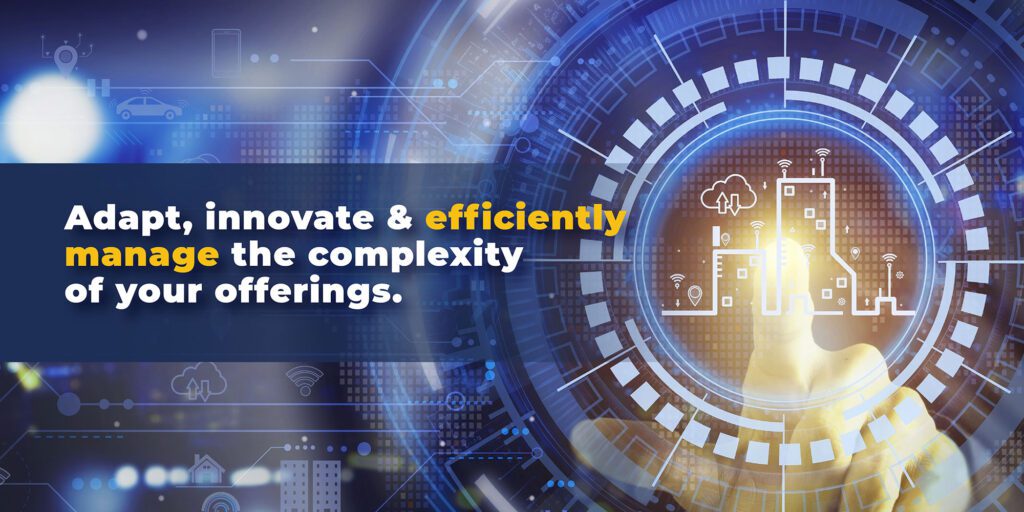
It’s crystal clear that multi-utility is the new norm when it comes to the types of offers and competitiveness in the utility market. However, this evolution has its own set of challenges. Multi-utility providers face hurdles in scaling businesses, managing diverse services and tariffs, adapting to new business models, ensuring accurate billing, and integrating varied systems and data.
To address these challenges, a multifaceted approach is necessary. This involves robust CRM and billing solutions that cater to the multi-play nature of these services. Such solutions must facilitate new services, offer comprehensive CRM and reporting functions, provide cross-product functionality, and manage diverse tariffs effectively. Additionally, understanding and navigating various tariff structures, from dual-fuel to EV charging tariffs, is crucial for both providers and consumers in this dynamic landscape.
In conclusion, the future of multi-utility services hinges on the ability of providers to adapt, innovate, and efficiently manage the complexity of their offerings to meet the evolving demands of the market and their customers.

Watch the Webinar “Empowering Innovative Multi-Offer Utilities.”
During this exclusive session, you’ll discover how to elevate your utility service delivery to higher levels. Our expert speakers have unveiled actionable insights and solutions to address the following key challenges:
- Overcoming limitations in scaling your business
- Effectively handling the complexities of diverse services and tariff plans
- Adapting to new business models to ensure competitiveness in the utility sector
- Minimizing errors in billing and accounting to ensure reliability
- Integrating varied data sources effectively while reducing costs
- Delivering simultaneous service provision across different domains
- Introducing new services and partnerships seamlessly
- Having a positive direct impact across various business departments
Related:
Half-Hourly Settlement: Is Your Utility Business ‘Reform-Able’?
Dynamic Energy Contracts to Harness Price Volatility and Get Loyal Customers
Energy As A Service Provisioning Model: Power of Digitalisation
Frequently Asked Questions
What is the meaning of multi-utility?
Multi-utility refers to a utility company providing conventional utility services (energy, gas, water, tenancy – municipal services) and now offering within its product and service portfolio a range of other services, such as EV charging, mobile, bandwidth, landlord cover plans, smart home solutions, etc.
What is the meaning of billing and CRM for multi-utility?
Billing and CRM for multi-utility refer to a comprehensive tech solution that allows managing all the services in one holistic CRM system and charges services under one end bill, eliminating siloed data, ops inefficiencies and extra costs.
Who are the big 6 utilities in the UK?
Based on the market cap, these are National Grid plc, SSE plc, Centrica plc, Severn Trent plc, United Utilities Group plc, Drax Group plc.
